Taking in an average of 13 million gallons of sewage per day, the wastewater treatment plant in Gresham, Ore. is one of the city’s largest users of energy. Located near the Columbia River northeast of Portland, the Gresham Wastewater Treatment Plant (WWTP) is a basic secondary activated sludge facility with 20 million gallons/day (mgd) of capacity.
Dating back almost 30 years, efforts were made to curb the plant’s big appetite for power. Anaerobic digesters were installed in 1990 to make the plant more efficient by deriving biogas from the solid waste matter that settles out during the treatment process. Raw, untreated biogas derived from the digesters fed a 250 kW generator that helped power about one quarter of the plant.
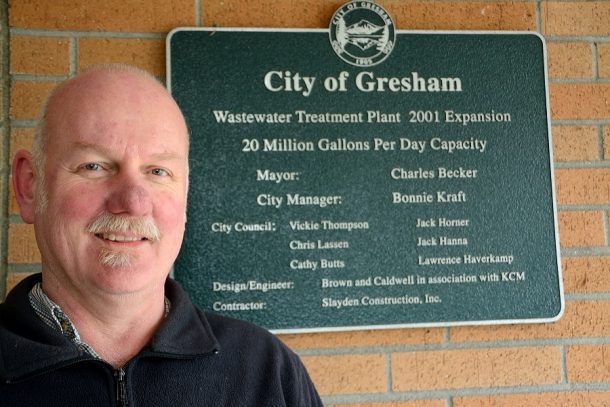
Alan Johnson, senior engineer with the city of Gresham, examined ways to make the Gresham WWTP more energy efficient with a focus on reducing power consumption while increasing biogas production.
“We wound up turning it off in 2002 when it burned out,” recalls Alan Johnston, senior engineer with the City of Gresham Wastewater Treatment Plant.
In 2005, after receiving grants from the Energy Trust of Oregon and the Oregon Department of Energy, the City installed a Cat® G3508 gas generator set that produces 400 kW in a combined heat and power (CHP) application. The cogeneration system includes a modern biogas scrubbing system that removes moisture, hydrogen sulfide and siloxanes. The Cat genset produces power and heats the buildings with jacket water heat. It has been supplying 50 percent of the treatment plant’s power needs since 2005, saving about $250,000 in annual avoided electrical costs.
But even with the addition of the Cat 400 kW cogeneration unit, excess biogas had to be flared, Johnston says. In 2007, Gresham’s mayor, Shane Bemis, signed a climate action agreement with the U.S. Conference of Mayors, which ultimately led Johnston to examine ways to make the WWTP even more energy efficient.
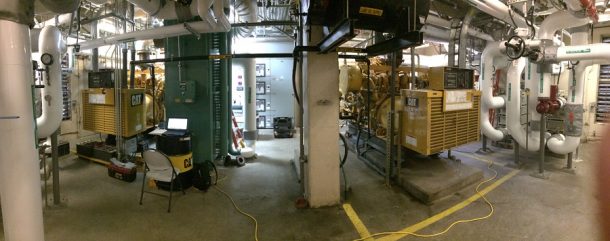
The Gresham WWTP generates 10 percent more electricity than it needs via a combination of energy efficiency, codigestion and cogeneration, and a solar array
The journey to net zero
After further analysis, Gresham decided to shift its focus in 2008-09 to reduce power consumption while increasing biogas production.
The journey to energy independence began in 2009 when the Gresham WWTP received a grant from the Oregon Economic Development Commission to study ways to increase the environmental and operational efficiency of the treatment plant. One outcome was a study on the benefits of accepting fats, oils and grease (FOG) from restaurants to remove them from the waste stream and instead use them to boost electrical generation.
Based on revenues generated by a FOG tipping fee at the facility and avoided electrical utility fees, the conclusion was that it would be cost-effective with an ROI of seven years. Gresham acted on the recommendation, and currently takes in about 13,000 gallons per day of FOG. The product is slowly injected into the digesters, and according to Johnston, the organic matter has nearly doubled biogas production.
“FOG has a lot of energy stored in it, or about 12 cubic feet of biogas produced for every gallon injected into the digesters,” Johnston says. “The study concluded that adding FOG receiving facilities is economically viable, and it turns out that there is a market for this service in our area.”
The increase in biogas production made possible the installation of a second Cat G3508 gas generator set in 2015, thereby increasing power output and allowing the facility to produce more electrical power than it consumes.
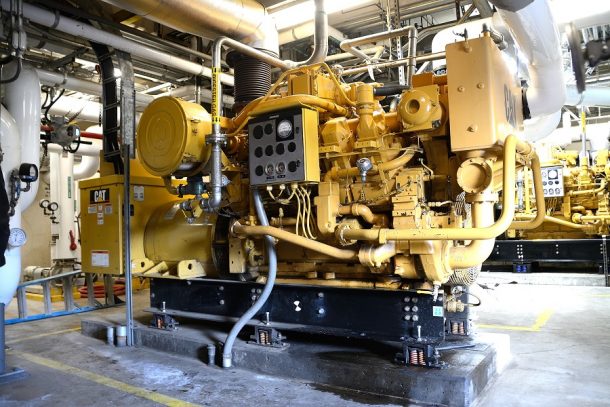
Cat® generator sets help the Gresham WWTP achieve energy net zero.
Energy net zero means producing the same amount of energy that a facility uses to operate.
For Gresham, net zero became a real goal in 2010 when investments were made as part of the capital improvement cycle. A formal energy management team was created, and Gresham established a goal of achieving energy net zero at the WWTP by 2015.
With support from management and staff, five major capital upgrades were phased in over a five-year span.
- Phase 1 (2010): Installation of a 420 kW solar array
- Phase 2 (2011): Power conservation project that reduced plant-wide power consumption by 17 percent
- Phase 3 (2012): Installation of a 10,000-gallon FOG receiving station
- Phase 4 (2014): Expansion of the FOG receiving station to 30,000 gallons
- Phase 5 (2015): Expansion of the cogeneration system from 400 kW to 800 kW with the addition of a second Cat G3508 generator set.
In February 2015, on schedule and on budget, the first energy net zero month occurred. The WWTP generated more electrical energy on site from renewable biogas cogeneration and solar power than it consumed. Today, the Gresham WWTP generates about 10 percent more electricity than it needs via a combination of energy efficiency, codigestion, cogeneration and a solar array.
“We didn’t do it just because it was fun and exciting, we did it because it made financial sense,” Johnston says. “That’s how the City of Gresham operates, and we showed over a 10-year period that we’d have a seven-year payback on all of these projects, and that’s really what sold it to the mayor.
“We’ve had a ton of support—all the way from my bosses to managers to the city council and mayor through all of these projects—and I’m glad it was so successful because I pushed it for years saying it would work, and it has.”
Over the 10-year journey to energy net zero, the Energy Trust of Oregon supported the City of Gresham with technical assistance, project development support, and cash incentives that lowered the costs of the energy efficiency measures—as well as the two CHP generator sets and the solar electric system. Business Energy Tax credits and biomass incentive funds from the State of Oregon also were essential to making net zero a reality.
“This was a really smart financial move for Gresham,” observes Betsy Kauffman, program manager for Energy Trust of Oregon. “Gresham had a champion who was willing to go to bat for this. They had a supportive mayor and city council, and they brought in partners who were able to help them move this forward.”
$1 million annual savings
Now entering its fifth year of operation as a net zero wastewater treatment plant, Gresham is the first facility of its kind in the Pacific Northwest and the second in the country to hold that distinction.
The net result is about $1 million in annual savings to the ratepayers of Gresham, which includes $500,000 in avoided utility costs, $350,000 from FOG tipping fees, and the balance in avoided costs by utilizing the jacket water heat from the generator sets to heat the buildings. As an added benefit, Class B biosolids that are the byproduct from the anaerobic digesters are applied to agricultural fields as fertilizer at no cost to area farmers.
“When you talk about our wastewater treatment, which traditionally has been our biggest energy hog, in less than 10 years it’s producing its own energy on site,” Bemis says. “So it’s not only green in terms of green energy, it’s green in terms of money.”
Adds Kauffman: “What’s really great about this project is they are using something that is truly a waste product—they’re taking methane and using it as a resource to generate their own electricity. And they don’t have an electrical bill to cover because of the efficiency work that they did.”
High uptime
Achieving net zero status is made possible by the high uptime of the Cat gensets, Johnston says. To ensure continuous operation, Gresham relies on its Cat dealer, Peterson Power Systems, which provides service through a Customer Support Agreement.
“One of the big reasons why we have a successful program here is because of the relationship we have with our local Cat dealer,” he says. “Anytime we have issues with the engines, we call them, and we have a guaranteed 24-hour interval for their technicians to come out here to fix the problem.”
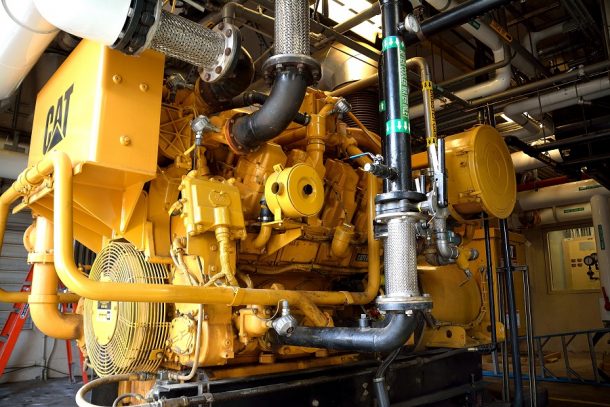
The Cat® G3508 gas generator set has been supplying 50 percent of the Gresham WWTP’s power needs since 2005.
Over four years, Gresham’s cogeneration plant has averaged about 95 percent uptime.
“And we couldn’t have done that without the support of Peterson Power Systems,” Johnston says. “If the Cat engines aren’t running, we’re in trouble. So, we try to average over 90 percent run time, and in over four years we’re at 95 percent and that includes all the overhauls, top end work, oil changes, and unrelated construction issues that take those engines down.
“So really, it’s a pretty impressive thing when you think about it—if the engines run 80 percent of the time, we’re not net zero,” Johnston adds. “It’s always easy in the honeymoon phase of big projects to have engines running good and everybody’s happy, but to have done it now for four years with all the issues you run into with older equipment, it’s pretty impressive.”
Gresham sole-sourced the second Cat generator through the National Joint Partnership Alliance (now known as Sourcewell). Peterson Power sales rep Marty Hopkins helped negotiate the cost, which also included Cat Switchgear, heat exchangers and PLC controls.
Gresham also has a Cat C9 standby diesel generator in the event of a grid outage. (Because the WWTP operates in parallel with the grid, the gas gensets automatically shut off during an outage and can’t serve as an emergency power source.)
Gresham also utilizes Cat S•O•SSM Services, a routine checkup for oil, coolant and fuel that delivers valuable insights which can be used to prevent unexpected failures and unplanned downtime.
“Just the other day one of the coolant samples showed a potential problem,” Johnston said. “And that’s why Peterson was here to change the coolant.”
Peterson technicians handle all preventive maintenance, including changing oil, spark plugs and coolant, as well as engine overhauls.
“And even for just general troubleshooting if it sounds like something’s not running right, we will call Peterson,” Johnston says. “They are always quick to respond, and it has been a pretty successful arrangement for us.”
Meanwhile, Johnston continues to look for ways to improve efficiency of the cogen plant. The WWTP still flares about 20 percent of the biogas from the digesters, and currently uses just 40 percent of the heat from the gensets. The WWTP is currently under construction to expand it’s hot water heating system to its equipment maintenance building to utilize even more of the heat produced by the engines, Johnston says.
“We’re always searching for ways to improve, and with the help of our energy partners, we will find the means to utilize that excess energy.”


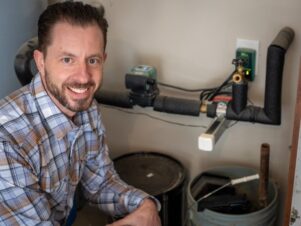

Join the conversation: